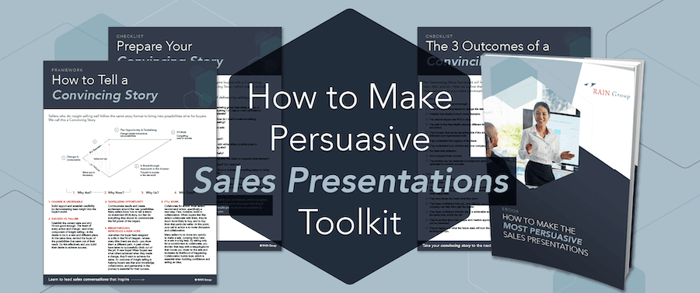What Is a Proposal Presentation?
A proposal presentation is a structured discussion that demonstrates the value of your solution to a buyer. It outlines the problem to be solved, explains how your offering provides the best solution, and includes defensible details to prove impact and ROI. It typically involves verbal delivery, discussion, Q&A, and any supporting materials (such as a demo, handout, or live walk-through).
As one of the final steps to close a sale, the proposal presentation is essential to answer lingering questions, demonstrate impact, and connect with decision-makers.
The preparation you do before the presentation is just as important as what you do during it. By now, you should have conducted a thorough needs discovery to serve as the foundation for your presentation.
Done well, a proposal presentation builds rapport, deepens trust, and serves as an experiential sample of what the buyer will get if they work with you.
Below we share the basic components of a proposal presentation and 13 tips to help prepare and build your confidence for your next presentation.
 Click here to download the PDF. >>
Click here to download the PDF. >>
Deliver Winning Proposal Presentations |
|
| Before the Presentation | During the Presentation |
Proposal Presentation Structure
A great proposal presentation is a compelling narrative that contrasts the buyer’s current state with the results they can achieve with your solution.
While every presentation will vary, the focus should always be on the value you provide. Keep the big picture in mind; be prepared to answer technical questions, but center your presentation on the transformation your solution enables and what it means for the buyer.
If you’re unsure of how to structure your presentation or make a case for change, consider building a Buyer Change Blueprint (BCB) first. A BCB maps out how the buyer can achieve their new reality, and why your solution is the best path to get them there.
Introduction
Take the lead right from the start by setting a clear agenda. If you’re presenting with a team, introduce them and their roles.
Demonstrate that you understand the buyer’s situation by briefly summarizing their afflictions and aspirations. Keep it short and simple; don’t dive too deep yet. The goal is to show you’ve been listening and set the stage for discussion.
Problems/Current State
Lay the foundation for your solution by clearly outlining the buyer’s challenges. However, avoid spending too much time on issues they’re already aware of.
This is where a strong needs discovery pays off. Go beyond surface-level problems and uncover root causes. Show the buyer that you understand their business at a deeper level and connect these challenges directly to what comes next.
New Reality
What does success look like? What’s the buyer’s desired outcome once their problems are solved? What’s the tangible impact of your solution?
Help them visualize their new reality, a changed future where they see measurable improvements. Use data, projections, or examples to make the vision feel tangible and exciting.
Your Solution
Now that the buyer is invested in achieving their new reality, it’s time to show how you get them there.
This section should:
- Clearly outline how your solution addresses their key challenges
- Highlight your differentiators, what makes your approach uniquely effective
- Connect each of your solutions directly to the problems you identified earlier
Rather than listing features, position your solution as the bridge between their current state and their new reality.
Case Studies and Proof
Substantiate your claims with evidence, such as case studies, data, testimonials, or third-party validation. More on how to provide compelling proof later in the article.
Next Steps
Close with a clear call to action. What needs to happen next? Align with the buyer on next steps, timelines, and responsibilities to keep momentum going.
8 Things to Do Before Your Proposal Presentation
1. Know the Players
Ask your champion or key contact about the meeting participants. Who will be in the room? What are their priorities? How do they prefer to engage?
One key factor is the balance between presentation vs. discussion. If you don’t have insight into their preferences, prepare a mix of both with some structured content and plenty of opportunities for dialogue. A conversation is always more engaging than a one-sided pitch.
2. Do Some Sleuthing
Remember, the buyer is the star of your presentation—not you. Make sure everything you say resonates with their business, goals, and pain points. Use LinkedIn, Google, and industry research tools to learn about the meeting participants. Look for insights such as:
- Industry trends impacting their business
- Recent company news (funding, leadership changes, acquisitions, etc.)
- Your differentiators in the context of their needs
- Their aspirations and strategic initiatives
Ideally, you’ve gathered this information through needs discovery conversations, but last-minute research can help refine your message.
Pro tip: Buyers will likely look you up before the meeting. Ensure your public profiles reflect credibility and value.
Download our LinkedIn for Sales Guide. >>
3. Define Your Roles
If you’re presenting as a team, clarify roles in advance.
- Will one person lead the discussion while others provide expertise?
- Who is responsible for introductions and closing?
- Who will handle Q&A?
Avoid role confusion. If multiple people take charge, no one is truly leading. Designate one person to orchestrate the presentation and keep things on track.
4. Involve Everyone
If you bring a team, everyone should participate. Buyers often cite one-sided team dynamics, where one person dominates while others stay silent, as a reason they rejected a provider.
Even if someone’s role is minimal (e.g., handling introductions or engaging in follow-up discussions), make sure they provide meaningful contributions.
5. Ask About Logistics
Small logistical issues can derail even the best presentations. Get clarity on these details ahead of time:
- Where is the meeting taking place?
- Are all participants in person or will some be virtual?
- Do remote attendees need materials in advance?
- How much time is allotted? Are there hard start/stop times?
- What technology platform will be used? If possible, use your own to maintain control.
6. Dress the Part
Your attire should align with the buyer’s culture.
- Presenting to a formal industry (e.g., finance, law)? Opt for business attire.
- Pitching to a casual tech startup? A suit might feel out of place.
Err on the side of professionalism, but don’t overdo it. Your goal is to match their environment, not stand out awkwardly.
7. Present with Confidence
Great content won’t save a weak delivery. Ensure your presenter(s) can command the room.
- If someone on your team isn’t a strong speaker, assign the lead role to someone else.
- Practice beforehand, especially for high-stakes presentations. Bring in critical team members to simulate tough questions and refine delivery.
Mistakes should be fixed in rehearsal, not in front of the buyer.
8. Be Strategic
Most proposal presentations are competitive. Understand your positioning.
- Ask the buyer directly who else they’re considering.
- If they won’t disclose competitors, ask about timing.
Scheduling tip:
- If all presentations occur on the same day, going first sets the benchmark and makes you the reference point (the primacy effect).
- If presentations span multiple days, going last increases recall and emotional connection (the recency effect).
5 Things to Do During Your Proposal Presentation
9. Build Rapport
- Start by creating a comfortable, engaging atmosphere; establishing trust early can set the tone for a productive discussion
- Extend warm greetings
- Make eye contact
- Break the ice with small talk
- Show genuine interest in their business
Come prepared with conversational tidbits, such as recent industry news, relevant insights, or shared connections, to help build camaraderie and rapport.
Read the article: How to Build Rapport in Sales. >>
10. Start Strong and Set Expectations
Take control of the meeting from the outset. Transition smoothly into your agenda and clarify why you’re there to ensure alignment.
A lack of clarity of purpose can cause meetings to go off track. Set expectations by stating:
- The goal of the discussion
- What the buyer should expect to gain
- How the time will be structured
Pro tip: Ask upfront if there’s anything specific the buyer wants to cover. This allows you to tailor your presentation in real-time to their priorities.
11. Invite Participation
A successful proposal presentation isn’t a monologue, it’s a conversation. Encourage buyers to engage, ask questions, and share their thoughts throughout.
Before you begin, explicitly invite interruptions and dialogue. This signals that their input is valued and keeps them actively involved.
Also, confirm the time available to adjust for early departures or additional discussion time if needed. If buyers interrupt you with questions, that’s a great sign—they’re engaged!
Download the ebook: 50 Powerful Sales Questions. >>
12. Be Persuasive
It’s one thing to know your impact model and quite another to communicate that impact persuasively and to influence and inspire action. Ask yourself:
- Can I tell a Convincing Story that makes the impact clear?
- Am I challenging the status quo in a way that provokes thought?
- Have I connected this decision to broader business goals?
Sellers who present with conviction and clarity drive stronger responses. The better you articulate your impact, the more likely you are to win the deal.
13. Share Stories and Proof
Buyers trust proof over promises. Strengthen your case with real-world success stories.
- Share relevant case studies that illustrate measurable impact
- If client data is sensitive, anonymize details while still showcasing results
- Use aggregate success metrics to reinforce credibility
The more relatable and compelling your examples, the more confidence buyers will have in your ability to deliver.
Your Presentation is a Collaboration
It's all too easy to talk at buyers during your proposal presentation, but the best presentations continue and reinforce collaboration with your buyer.
If you want to leverage your proposal presentations to build these strong connections with your buyers, you'll have to put in the work. When you do so, you'll have the perfect opportunity to close out the deal on a high note and get the buyer excited about moving forward with your solution.
 Have you ever delivered a sales presentation that fell flat? You aren't alone. Get the resources you need lead collaborative presentations that win in our How to Make Persuasive Sales Presentations Toolkit. Download now. >>
Have you ever delivered a sales presentation that fell flat? You aren't alone. Get the resources you need lead collaborative presentations that win in our How to Make Persuasive Sales Presentations Toolkit. Download now. >>





